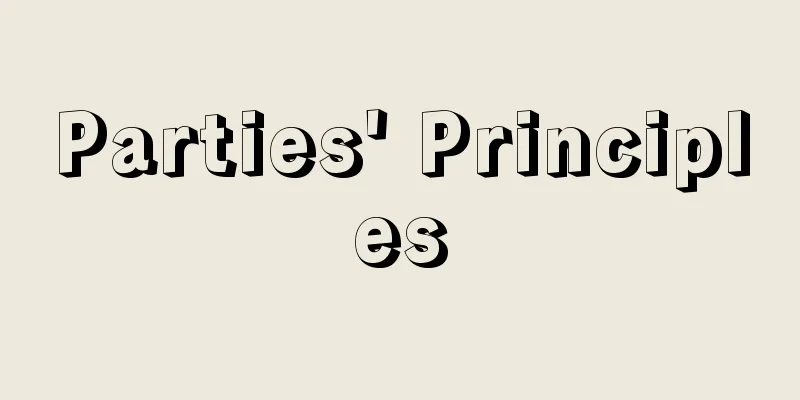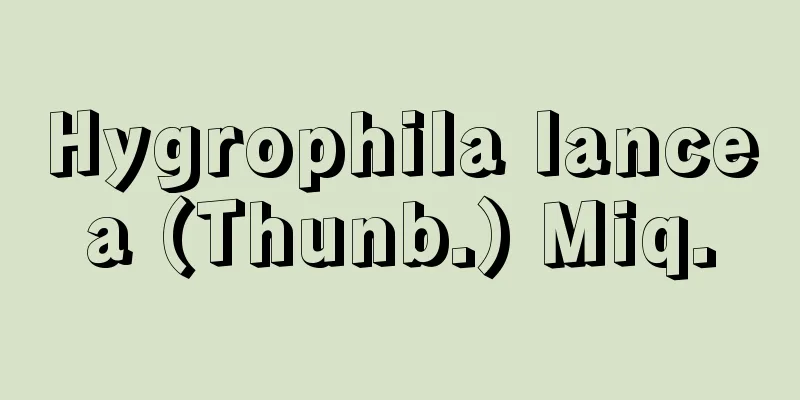Parties' Principles

|
This is the idea that the parties have more control over the hearings and progress of litigation proceedings than the court, and is a concept that is opposed to the principle of official discretion. [Takeyoshi Uchida] Adversarial Principles in Civil LitigationA lawsuit is a procedure that develops continuously and step by step through the actions of the parties and the court. Civil lawsuits have the inherent contradictory nature of resolving private disputes publicly. Therefore, from the viewpoint of whether the parties should take the initiative in the development of this lawsuit procedure or whether the court should have the authority, party-based and official-based are in conflict. Originally, modern civil procedure law was born under the laissez-faire ideology of the 19th century, so the public nature of the procedure was not emphasized very much. However, when party-based law was thoroughly implemented, the disadvantages such as delays in litigation became evident, so official-based law was gradually introduced afterwards. Japanese civil procedure law has also developed along this line. However, unlike criminal procedures, civil lawsuits cannot be neglected in terms of private aspects, so there is naturally a limit to the advancement of official-based law. Therefore, the current general trend in countries around the world appears to be to preserve the party principle (the principle of dispositional power and the principle of orality) with some modifications, such as through litigation direction power, in terms of identifying the subject of arbitration and collecting litigation materials, while strengthening the principle of official power (the principle of official progress) in terms of the progress of litigation procedures. [Takeyoshi Uchida] Adversarial Principles in Criminal ProcedureThis principle gives the initiative in the progress of the trial to the parties, i.e., the prosecutor and the defendant. Immediately after the current Criminal Procedure Code came into force, it was understood that the structure of the parties' lawsuit in criminal proceedings was merely a technical party structure aimed at protecting the defendant, but gradually it became generally understood that the party principle is the basic structure of the current Criminal Procedure Code. That is, (1) the current law adopts the so-called indictment-only principle (the principle that the prosecutor submits only the indictment when instituting prosecution) (Criminal Procedure Code, Article 256, Paragraph 6), and the evidence held by the prosecutor is no longer handed over to the court. This has cut off the continuity between the investigation and the trial, and the court enters the trial with a blank slate. Therefore, requests for evidence examination are made by the prosecutor, the defendant, or the defense attorney (Criminal Procedure Code, Article 298, Paragraph 1), and witness examination is generally conducted by alternating parties, even though the Criminal Procedure Code, Article 304, Paragraph 1, gives priority to the presiding judge's examination (Criminal Procedure Rules, Article 199-2 and following). In addition, (2) the current law adopts the so-called prosecution convenience principle, which allows prosecutors to suspend prosecution at their discretion (Article 248 of the same law), gives the prosecutor the authority to decide whether to prosecute or not, and even if prosecution is decided, the prosecutor is responsible for establishing and changing the charges (Article 256, Paragraph 3, Article 312, Paragraph 1 of the same law). In this way, the party principle is allowed to take the lead in the most important part of the trial procedure, which is evidence and charges (this is called the party deferential principle). Therefore, the provisions of (3) the court's ex officio examination of evidence (Article 298, Paragraph 2 of the same law) or an order to change the charges (Article 312, Paragraph 2 of the same law) are positioned as exceptional systems under the current law. However, there are many different understandings of party principle. In addition to the understanding that the parties should be allowed to take the initiative in the progress of the trial, there is the understanding that the parties should be allowed to take the initiative in the progress of the trial, the understanding that the parties should be allowed to strengthen the defendant's defensive capabilities because there is a disparity in the offensive and defensive capabilities between the prosecutor and the defendant, the understanding that the parties should be allowed to have the right to dispose, and even the understanding that the protection of the rights of suspects and defendants, that is, due process itself, is party principle. However, the core of party principle is party principle. In particular, with the introduction of pretrial consolidation procedures by the amendment to the Code of Criminal Procedure in 2004, trial hearings are now centered on the issues asserted by the parties rather than the case itself, further strengthening the significance of party principle. Case law has also come to recognize that trial hearings based on pretrial consolidation procedures are premised on party principle (party principle) (Supreme Court Second Petty Bench decision of October 16, 2009). Regarding the principle of the parties' right to dispose, a distinction is made between the right to dispose regarding litigation procedures and the right to dispose regarding the subject matter of litigation (the charges in criminal litigation). In principle, litigation procedures are based on the principle of official discretion, but the system of the defendant's statement of guilt in summary trial procedures, the suspect's consent in summary trial procedures, the suspect's objection system in summary procedures, and even consent to evidence are systems that grant suspects and defendants certain procedural disposition rights. In contrast, with regard to the right to dispose of the subject matter of litigation, it is clear that the principle of disposition is granted to prosecutors through the principle of expedient prosecution, the system of dismissal of charges, and the system of charges, but with regard to defendants, it is stipulated that they will not be found guilty even if they admit their guilt (Article 319, Paragraphs 2 and 3 of the same law). [Moriichi Taguchi] [Reference] | | | | | | | |Source: Shogakukan Encyclopedia Nipponica About Encyclopedia Nipponica Information | Legend |
|
訴訟手続における審理や進行などについて、裁判所の職権よりも当事者のほうに主導権を認める考え方で、職権主義に対する概念をいう。 [内田武吉] 民事訴訟における当事者主義訴訟は、その主体である両当事者と裁判所の諸行為によって連続的・段階的に発展する手続である。そして民事訴訟には、私的な紛争を公的に解決するという矛盾した性格が内在している。そこで、この訴訟手続の展開について、主導権を当事者が握るか、あるいは裁判所が権限としてもつかという観点から、当事者主義と職権主義とが対立することになる。元来、近代民事訴訟法は19世紀における自由放任思想のもとで誕生したので、公的性格はあまり強調されなかったが、当事者主義を徹底すると訴訟遅延などの弊害が顕著となったため、その後、漸次、職権主義が導入されることとなった。日本の民事訴訟法もこの流れに沿って発展してきている。しかし民事訴訟は刑事訴訟とは異なり、私的側面を軽視することはできないので、職権主義の進出にもおのずから限界がある。そこで、審判対象の特定と訴訟資料の収集については、訴訟指揮権などにより若干修正を加えながら当事者主義(処分権主義と弁論主義)を保存し、訴訟手続の進行については職権主義(職権進行主義)を強化するというのが、現在の各国の一般的傾向とみられる。 [内田武吉] 刑事訴訟における当事者主義訴訟進行の主導権を当事者すなわち検察官と被告人に与える原則をいう。現行刑事訴訟法の施行直後には、刑事手続における当事者訴訟の構造は、単に被告人の保護を目的とする技術的当事者構成だとする理解も示されたが、その後、しだいに、当事者主義が現行刑事訴訟法の基本構造であるとする理解が一般的となった。すなわち、(1)現行法は、いわゆる起訴状一本主義(公訴を提起する際、検察官が提出するのは起訴状のみとする原則)を採用し(刑事訴訟法256条6項)、検察官の手持ち証拠が裁判所に引き継がれることはなくなった。これにより、捜査と公判との連続性は遮断され、裁判所は白紙の状態で公判に臨むこととなった。したがって、証拠調べの請求は、検察官、被告人または弁護人が行い(同法298条1項)、証人尋問も、刑事訴訟法第304条1項が裁判長の尋問を優先したにもかかわらず、当事者の交互尋問によることが原則となった(刑事訴訟規則199条の2以下)。また、(2)現行法は、検察官の裁量による起訴猶予を許すいわゆる起訴便宜主義を採用し(同法248条)、起訴・不起訴の決定を検察官の権限とし、起訴する場合も、訴因の設定・変更は検察官が行う(同法256条3項、312条1項)こととした。このようにして、証拠と訴因という公判手続の最も重要な部分について当事者主義の主導権を認めた(これを当事者追行主義とよぶ)。したがって、(3)裁判所の職権証拠調べ(同法298条2項)あるいは訴因変更命令(同法312条2項)の規定は、現行法上は例外的な制度と位置づけられることとなった。 もっとも、当事者主義の理解は多岐にわたる。すなわち、当事者に訴訟進行の主導権を認めるべきであるとする当事者追行主義の理解のほか、検察官と被告人との間には攻撃・防御の能力に格差があるため、被告人の防御能力を強めるべきであるとする当事者対等主義(あるいは武器対等の原則)との理解、当事者に処分権を認めるべきであるとする当事者処分権主義との理解、さらには、被疑者・被告人の権利保障すなわち適正手続それ自体を当事者主義とする理解などである。しかし、当事者主義の中核は当事者追行主義にある。とりわけ2004年(平成16)の刑事訴訟法改正により導入された公判前整理手続により、公判審理も事件そのものというより当事者の主張する争点を中心に進められることになり、当事者追行主義の意義が一層強化された。判例も、公判前整理手続に基づく公判審理が当事者主義(当事者追行主義)を前提とすることを認めるに至っている(平成21年10月16日最高裁判所第二小法廷判決)。 当事者処分権主義については、訴訟手続に関する処分権と訴訟物(刑事訴訟においては訴因をいう)に関する処分権が区別される。訴訟手続に関しては職権主義によることが原則であるが、簡易公判手続における被告人の有罪である旨の陳述の制度、即決裁判手続における被疑者の同意の制度、略式手続における被疑者の異議の制度、さらには、証拠への同意などは、被疑者・被告人に一定の手続処分権を認めたものである。これに対して、訴訟物の処分権は、検察官については、起訴便宜主義、公訴取消し制度、そして訴因制度により処分権主義が認められていることは明らかであるが、被告人については、有罪の自認があっても有罪とはされないと規定されている(同法319条2項・3項)。 [田口守一] [参照項目] | | | | | | | |出典 小学館 日本大百科全書(ニッポニカ)日本大百科全書(ニッポニカ)について 情報 | 凡例 |
<<: Inquiry of the parties involved
>>: Doctrine of the autonomy of the parties
Recommend
Jiříz Poděbrad
Born: April 23, 1420, Podiebrat [Died] March 22, 1...
Giant assassin bug - Ootobi sashigame
…The red-spotted assassin bug Haematoloecha is a ...
Public housing - kodanjutaku
〘 noun 〙 Apartment complexes built by the Japan Ho...
Constellation Quick Guide - Seiza Hayami
A simple star chart that allows you to see at a gl...
School bug (gnathostome) - School bug
It is a nematode of the family Dictyostelium that ...
Securities Agent - Shoken Daikou
A company that handles the affairs that a company ...
Ottoman Turkey - Osman Torko
...The basic plan was based on the simple flat-ro...
Korean Blacksmith - Karakanuchi
〘Name〙 One of the blacksmiths who served the Great...
International Trade Secretariats
…Abbreviation for International Trade Secretariat...
Kyonohimo (English name) Grateloupia okamurai
A seaweed in the family Centipediaceae of the orde...
Lending interest rate - Kashidashikinri
The interest rate that banks and other financial i...
Cominform - Cominform (English spelling)
Abbreviation for the Communist Information Bureau...
Prêtre, JG (English spelling) PretreJG
...The period from 1780 to 1830 was the golden ag...
Villon, Jacques
Born July 31, 1875 in Danville [Died] c.1963. Fren...
Capacitance type electric blood pressure monitor
… [Electronic sphygmomanometer] In the direct met...









